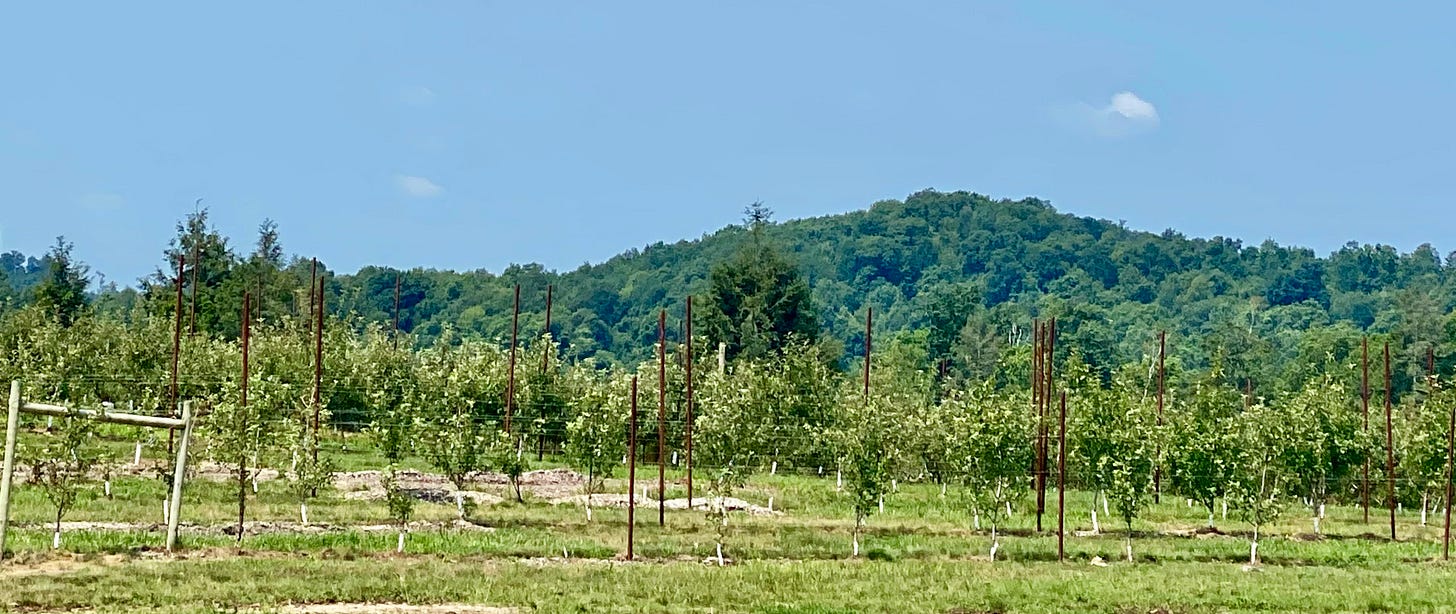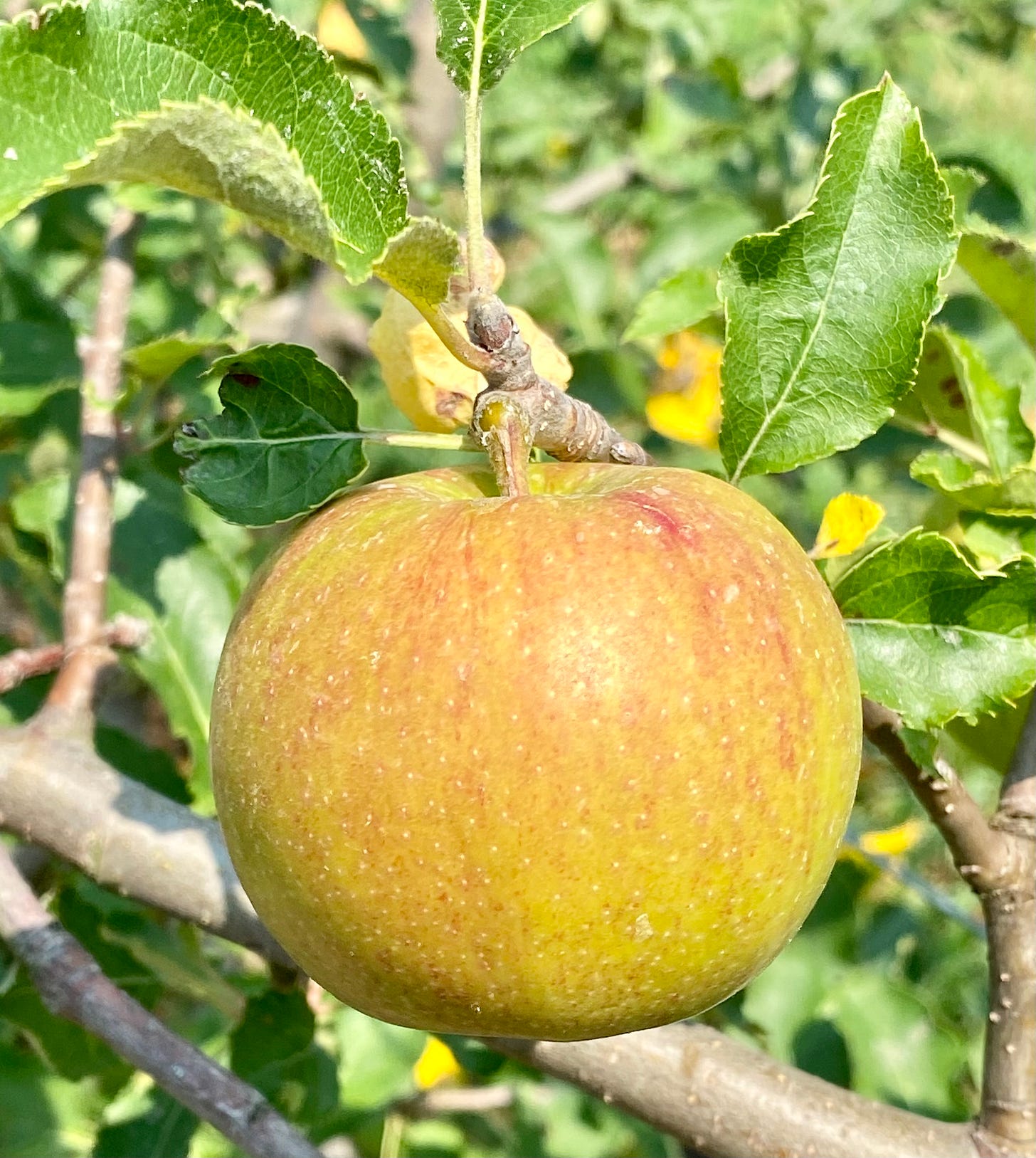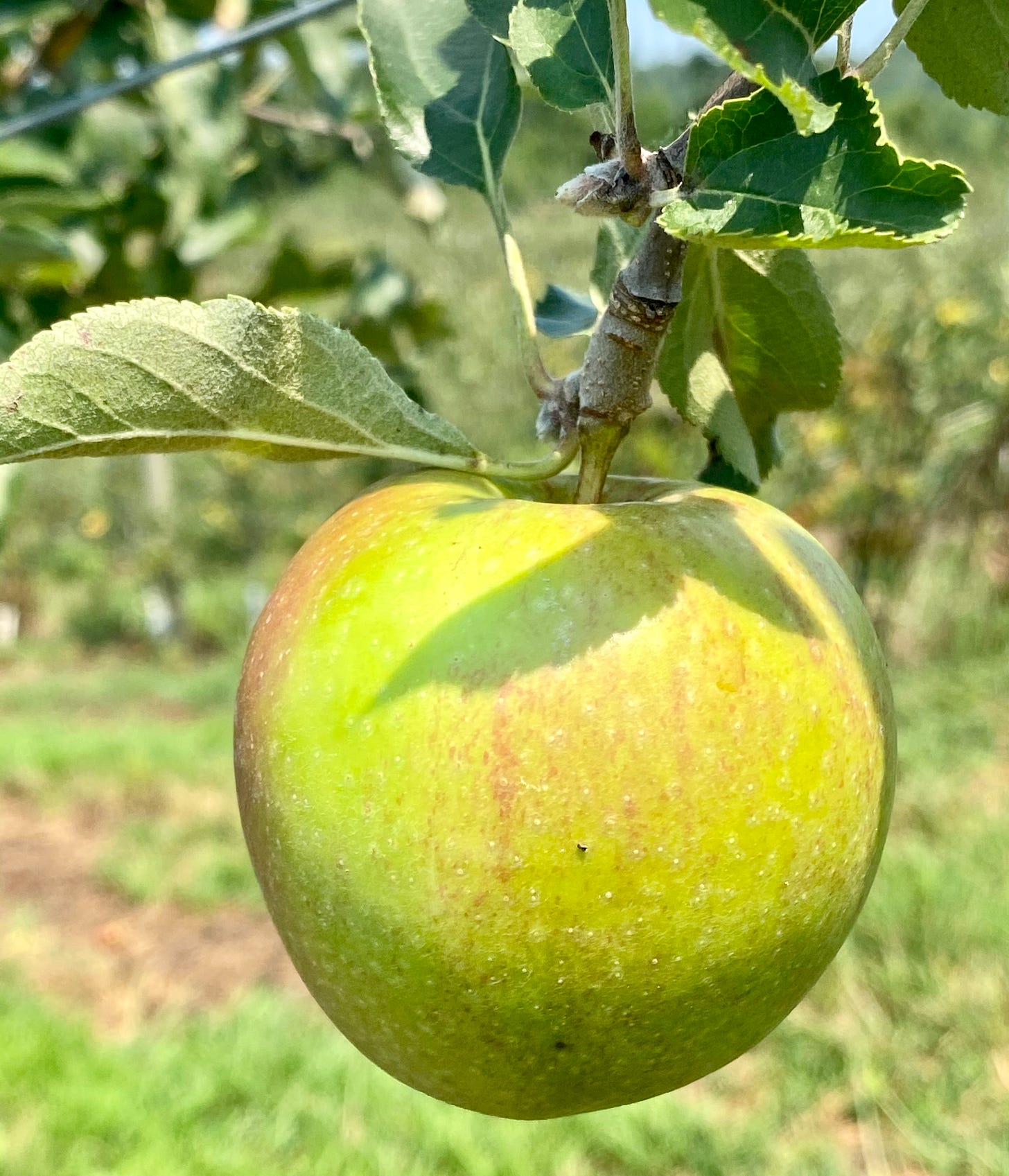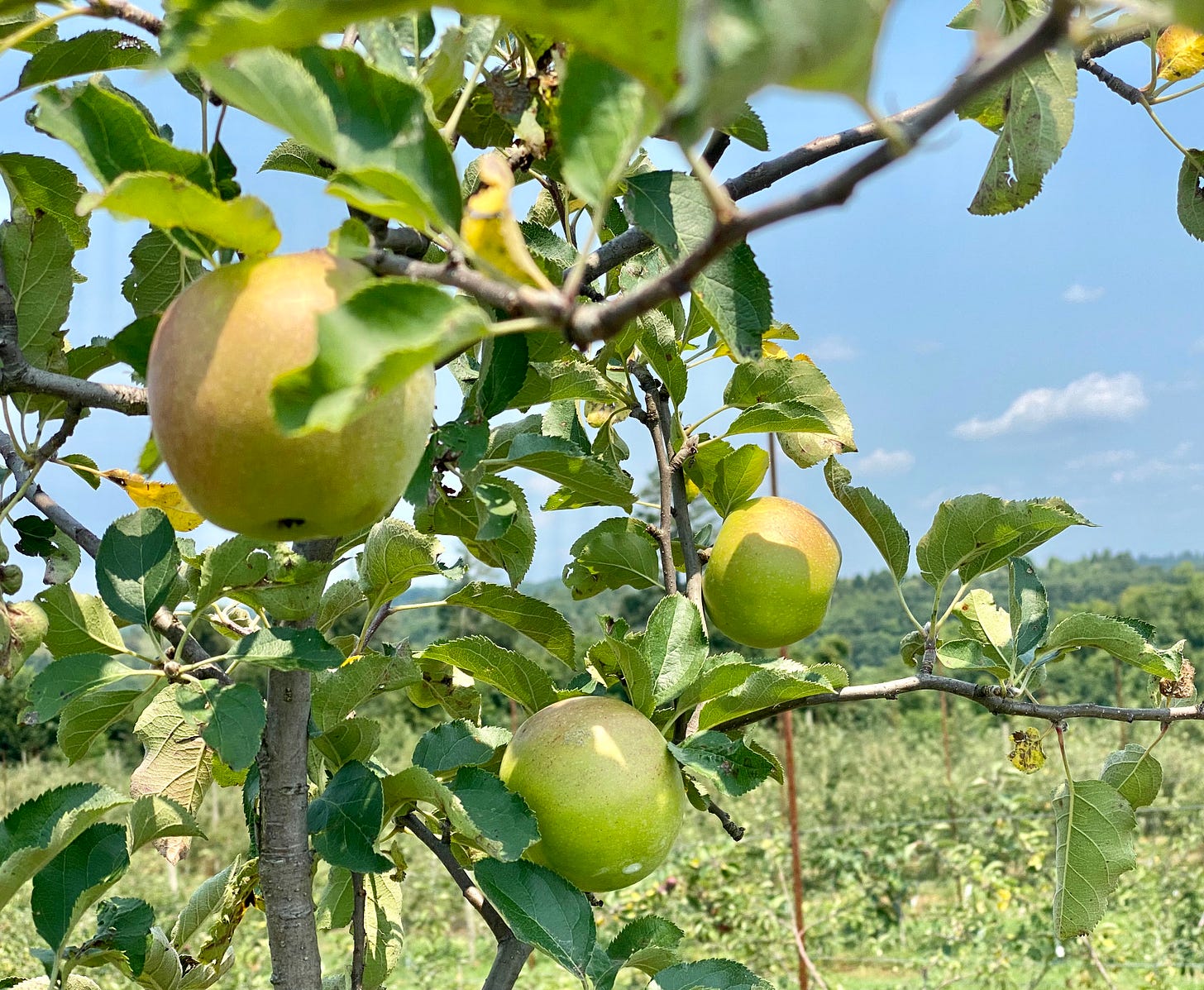Can Apples Grow on Reclaimed Mine Land?
AppleAtcha is promising a "revolutionary" AgriTech industry in Martin County. But what does the science say?
When I asked Alex Wiesen, co-owner of Michigan-based Empire Trellis about staking apple trees on reclaimed mine land versus the typical loamy soil of his home state, he laughed. “Well, with this project, there’s the rock. It’s rocky—very rocky—and we were battling. We were fighting each other, equipment versus rock. There had to be a lot of rock taken out of there. But I think we won, in the end.”
Wiesen and his team—who travel around the country installing large-scale agricultural trellises for everything from apples and grapes to hops—were tasked with a whopping, novel project over the summer: erect 60 acres of trellises, with 2,200 apple trees per acre, on a reclaimed mine site in Martin County, Kentucky in hopes of creating a high-density orchard. “This project is the first of its size and caliber for Eastern Kentucky. They’re doing something revolutionary.”
(Planting Honeycrisp apples at the AppleAtcha reclaimed mine site, via Facebook)
The project, known as AppleAtcha (a likely nod to the way locals tell people from outside the region how to pronounce Appalachia correctly: “If you do it wrong, I’ll throw an apple ‘atcha!”) is being developed by former coal baron Jim Booth as a way to turn a profit—potentially—on a surface mine site that his company, Cambrian Coal, abandoned after declaring bankruptcy in 2019.
At a politician-studded press conference in June, Booth was lauded as a “visionary” by former State Representative Rocky Adkins, and Governor Andy Beshear touted AppleAtacha as part of larger efforts to make Eastern Kentucky a global AgriTech capital. AppleAtcha investors like former Cambrian Coal President Joe LoConti and ‘80s NFL quarterback Bernie Kosar sang the project’s praises, with LoConti noting that he believes Martin County will become the “Napa Valley for apples.”
Booth said that he sees the project bringing about 4,000 jobs to Martin County: 2,000 full-time and 2,000 seasonal.
But anyone who lives in the region knows that new economic development ventures that are described as “revolutionary” should be met with a healthy amount of skepticism. Does the science support being able to grow apples on reclaimed mine land? Will the apples be safe to eat? The biggest apple producing states are Washington, Michigan and New York—will Kentucky’s (much warmer) climate work for such a large-scale project?
Fortunately, there is a research-driven, years-deep blueprint for growing apples on reclaimed mine land in Appalachia underway in Nicholas County, West Virginia—just three-and-a-half hours from Martin County. Using part of the $5.3 million in Abandoned Mine Land (AML) funds allocated to the state in 2015 to spur both economic growth and hasten mine reclamation, Patriot Guardens is an ultra-collaborative, National Guard-led effort to figure out how to best grow apples on the stripped-down, nutrient-depleted soil of former mine sites. Over half-a-decade of tinkering, pivoting and trail-and-error with a plot of 3,000 research trees has led the scientists behind Patriot Guardens to some recent, tears-of-joy successes—but not without a lot of headaches.
Booth and the AppleAtacha team—who have not reached out to their fellow reclaimed mine land apple growers at Patriot Guardens—could stand to learn a lot from the work happening in West Virginia. And despite the fanfare over the summer, there’s no clear way to contact anyone at AppleAtacha, including Booth’s son-in-law Ryan Wilson, the fledgling apple orchard’s project manager and former human resources director for Booth Energy. (In fact, the AppleAtcha URL is already owned by a t-shirt company out of Northeast Tennessee selling moonshine jug earrings and “Trump is the Gold Standard” bumper stickers.)
Agriculture is a far cry from coal mining, the arena in which Booth has built a lucrative career. Soil pH doesn’t care if you’re a former University of Kentucky trustee, and working to nourish and grow trees requires the exact opposite impulses than the brute-force destruction of digging for coal. So, what can be learned from the scientists, researchers and military personnel running the Patriot Guardens project in West Virginia? In my estimation, quite a bit.
Lessons AppleAtcha Could Learn from the Patriot Guardens Project
Relying on Local Collaborations
For Melissa “Mel” Stewart—who oversaw ag extension at West Virginia State University prior to becoming Patriot Guardens’ director—it’s the balancing act between meticulous, methodical biologists dedicated to the project and the always-ready-to-pivot National Guard leadership that has made the often bumpy road to growing apples on reclaimed mine land finally, ahem, bear fruit.
“The attitude toward [Patriot Guardens] has been if it's not working, you change it. You keep going. If the wing falls off, you pick it up, you put it back on, but at no time do you stop, because as soon as you lose that momentum, you lose that spark,” says Stewart. “And I will honestly say that it has not lost its spark since 2015. We’ve had to pivot 20 billion times. Everybody involved in this project will say there is nothing perfect about what we have done, or what we've had to overcome to get to this point, but none of us gave up. We stuck in there together, and now we're starting to see it really click.”
This also means that Stewart sometimes serves as a translator of sorts between scientists and the military. “In order to best utilize the avenue that Patriot Guardens has decided to go down, and really put it in a research-led mindset, I’ve had to help bridge that gap between the scientists and the military,” Stewart explains, noting that the team has recently hired a new soil scientist to assist with growing efforts. “And sometime, those conversations didn't translate very well. I’ve almost turned into a liaison of sorts to help both sides really understand we're all trying to get to that same end point, but we have very different methods to get there.”
These day-to-day conversations at Patriot Guardens to ensure clear understanding and a unified front in approaching apple growing on reclaimed mine land doesn’t seem to be playing out the same way in Martin County.
The company hired to be the “experts behind the growing,” according to Wiesen is AppleQuest, a high-density apple grower based out of Conklin, Michigan. When I spoke to AppleQuest CEO Bruce Rasch—who was on a chartered fishing boat during our call, leading to quite a bit of bizarre, reel-and-rod-themed cross-talk—he couldn’t remember the names of any scientists from Michigan State University who had worked to get the soil adjusted in Martin County, but seemed thrilled about the sheer quantity of trees that had been planted.
“High-density apple planting has evolved into the game we're playing, which is more trees per acre, which gets you more bushels at an earlier age in the tree’s life. This isn't the kind of planting most people would've worked,” Rasch says of the AppleAtcha project. “That’s because of the number of trees per acre. There are acres planted with 2,253 trees. That’s an intense plant, but for all the right reasons. It's for profitability in a shorter period of time.”
But if it’s unclear whether or not the soil itself can support the growth of apple trees—let alone that many trees per acre fighting for nutrients—profitability seems to be a concern that’s a long way away.
(Patriot Guardens, Nicholas County, West Virginia. Photo: Mel Stewart)
Getting pH Levels Balanced
The biggest issue in getting apples to grow on reclaimed mine land? Fixing the soil’s pH.
“The original pH was 4.2 in the area where the first 3,000 trees are planted, which is best for blueberries or something that's acid-loving like rhododendron or azaleas. But apples want closer to a 6 or 6.2 pH,” explains Stewart. “One project we’ve been working on is amending the soil by taking chicken manures from the northern region of the state…and bringing it to our site, then doing composting of the manure with sawdust as well as biochar and applying these layers of manures and sawdust to see if we can amend those soils with specific ratios.”
Turns out it’s working. “With the trees we have onsite, the pH is now back in line. After years of battling, we finally have tamed that monster, and have a better mindset of how you can get that part back in check. But at the same time, we're building up that organic matter. Not only adjusting the pH, but then starting to almost develop topsoil from scratch.”
USDA horticulturalist Doug Raines with the Appalachian Fruit Research Station is impressed by how their remediation efforts have improved the soil’s ability to support apple production. “It was no big surprise that the pH was very low, which means the soil was very acidic. The way you counteract the acidity in the soil is by adding lime. All-in-all, we had to apply about six tons of lime per acre, which is a lot. The recent soil tests that we’ve taken have actually shown a big improvement. We’ve gone from about a 4.25 pH up to about 6.5 pH, in a little less than two years, so that's really remarkable. And we needed a few different components as far as hydrogen, phosphorous and potassium, and we're adding those, too. But the difference in the trees’ growth this year is just unbelievable.”
With the Martin County project, Rasch couldn’t provide specifics about how the pH had been tested and shifted prior to planting the trees, but notes that the team from Michigan State “was puzzled, because there weren't many values to the soil that could contribute to the life of the plant, though there were some, like calcium. We needed to find the right crop that would interact with the dirt that we had, stimulate it and make it live. And that's what we did. You don’t want to fail on a project this big.”
Measuring the success of AppleAtcha, though, is still years away.
“On some of these sites, you go out and it’s like you’re on the lunar landscape of the moon. There's really not much there. The particular site we are on right now [for Patriot Guardens] was not actively mined itself. It’s adjacent, but it still was impacted and utilized as part of the mining process. It’s as depleted as the rest of it,” says Stewart, who points out older reclaimed mine sites—say, from the 1980s—tend to work better than recently mined areas when it comes to balancing pH and rebuilding topsoil. (AppalAtcha’s site in Martin County has been mined very recently.)
And is there any issue with eating fruit from trees grown on reclaimed mine land? While this is all still hypothetical, Dr. Chris Barton, Professor of Forest Hydrology and Watershed Management at the University of Kentucky, says probably not. “You would need to test the crop to ensure that you haven’t phytoaccumulated any metals or other toxic elements. However, unless you are planting on coal waste, slurry or ash, the levels tend not to be high in most reclaimed mine spoils.”
(An apple [!] at Patriot Guardens, Nicholas County, West Virginia. Photo: Mel Stewart)
Testing Out Different Varieties of Apples
At Patriot Guardens, Dr. Chris Dardick, a plant molecular biologist with the USDA Appalachian Fruit Research Station, has supported a slow-and-steady approach to grafting and growing different types of apples on the reclaimed mine land, seeing which varieties work best—under somewhat suboptimal growing conditions—over time.
Alternatively, in Martin County, all 86,000 apple trees planted are Honeycrisp, a type that Wiesen acknowledges are “harder to grow” than many other apple breeds, but currently bring the most bang-per-buck, pricewise, on the national market. It’s 180-degree difference in attitude toward growth: plant tens of thousands of the same type of apple on questionable, mined-up soil with visions of dollar signs dancing in your head, or take the time to do research on the front-end for, hopefully, greater growing success down the road.
“Fruit trees do well on marginal soils in general, but we still have some research and development to do to really optimize production. We want them to be very productive so they can be profitable,” says Dardick. “One of the things you have to consider is that apple trees are grown as scions on rootstocks, so the rootstocks are selected for various qualities: some tend to be more durable and resistant to abiotic stress and drought and things like that—diseases. And they also can be used primarily for reducing the size of the tree, so they can…cause the trees to flower sooner. Normally, if you plant an apple tree, it won't flower until seven or eight years after you plant it. The dwarfing rootstock can get them flowering within just two to three years, which means as a farmer, you're going to start getting return on your investment much sooner.”
On reclaimed mine land, though, Dardick and his team weren’t so sure a high-density plant with dwarfing rootstock (the kind undertaken at AppleAtcha) would be supported. “Today, most of the newer apple orchards are what we call high-density orchards: they're planted on very dwarfing rootstocks, very tight spacing and the trees remain very small. Easier to manage, you get more fruit-per-acre. But on land like this, we weren't sure if we could do that. We didn't know if it would support them, because those require good soil and fertility. So, the initial planting that was put in was designed to account for different varieties on different types of rootstocks, whether they're dwarfing, semi-dwarfed or standard. That was the idea.”
And, turns out, slow-and-steady works. Patriot Gardens’ apple trees bore their first fruit in 2021, overcoming everything from pH issues, to pest infestations, to a hard freeze that almost wiped out a quarter of the trees.
(Another apple [!] at Patriot Guardens, Nicholas County, West Virginia. Photo: Mel Stewart)
Not Overpromising on Jobs
Much like AppleAtacha’s aim in Eastern Kentucky, Patriot Guardens hopes to one day be a driver of economic growth across West Virginia, using what they’ve learned to educate and support potential farmers in building their own apple orchards. But unlike AppleAtacha—which Booth has already touted as bringing 4,000 jobs to Martin County (pop. 12,939)—the project hasn’t promised any set number of jobs: a move that is not only prudent, but the only reasonable option, given the fact that the trees just started to produce any apples after six years of intense work.
“We’re trying to incorporate training programs, because the learning curve with apples is so steep. This is a year-round job, because when you're not growing the apples; you're pruning the apple trees in the off-season; you're picking apples in the fall; and you're planning for the next year, because apples are in the ground year-round. There's always something to do,” says Raines, who has hosted several pruning and grafting workshops. “Apples are one of the most complex crops you can try, because of all the disease problems, the insect problems, the cultural practices.”
For Raines, education prior to job-promising is key. “Everybody seems real interested in what we're doing. We're trying to develop a workforce, so if the orchards take off, there'll be people ready to hire that can work in these positions because they have experience. They have seen an apple tree, and they know how to prune an apple tree, so they're not coming at it completely from the dark.”
Currently, no training programs have been announced for AppleAtcha to begin building up a well-informed workforce.
(Apples at Patriot Guardens, Nicholas County, West Virginia. Photo: Mel Stewart)
Letting Appalachian Scientists Lead
Why has Booth elected to grow apples on this former mine site? Truly, who can say. (As I mentioned, it’s seemingly impossible to find a direct contact for AppleAtcha.) Outside of the steadfast efforts of Patriot Guardens, most research points to the fact that apples don’t grow very well on reclaimed mine land.
An earlier attempt to develop apple orchards at an abandoned mine site in Clay, County, West Virginia—birthplace of the Golden Delicious apple—failed due to (what else?) poor soil. And a 2018 study from a team including West Virginia University soil scientist Dr. Jeff Skousen, which studied the survival and growth of 20 species of trees and shrubs on Appalachian surface mines, showed apples have a lukewarm performance…at best. Between 24 and 57 percent of trees survived, depending on planting site, and none bore fruit. (One factor that can help the trees at least survive? Plant them in an eastern-facing direction.)
But it only makes sense that if Booth and the AppleAtcha project are serious about succeeding, they would reach out to the Patriot Guardens team for assistance and support. If you’re aiming to bring apple orchards to Eastern Kentucky as an economic development tool, why not build off of the research that’s been done for years by nearby experts?
Stewart and her team are standing by, willing to give aid. “Anybody else who is looking to do this type of agricultural application with apples on post mine-use lands, they don't have to go through all the hurdles that we have. Here's what's worked. Here's how we remediated it. Here's the results. Here's other avenues we're looking at. Because until you’ve been doing it for years, it’s all pretty hypothetical.”
Looking for a way to help your neighbors this holiday season? Give back directly to those in need in our region by supporting Eastern Kentucky Mutual Aid:











